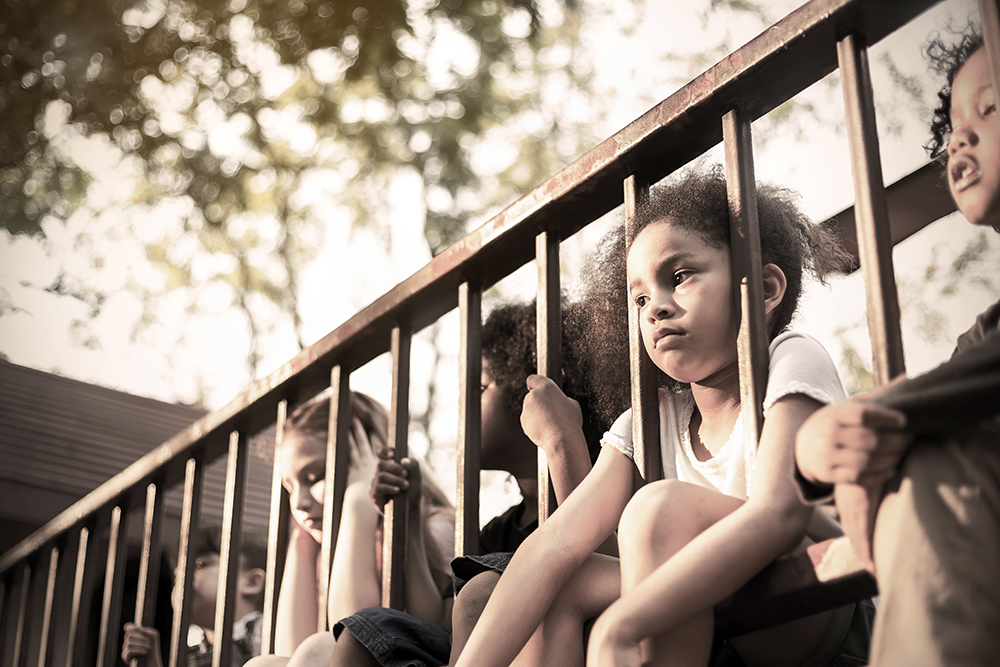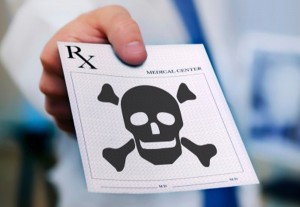25% of foster care children are still being subjected to psychotropic drugs, despite decades of government oversight. Medicaid accounts for 80% of all antipsychotic prescriptions in the U.S., costing more than $3.63 billion.
By CCHR International
The Mental Health Industry Watchdog
February 3, 2023
Recently, Maryland’s Department of Human Services (DHS) and its Social Services Administration (SSA) were criticized for failing to maintain adequate monitoring of antipsychotics and other psychotropic drugs prescribed to foster care children—despite oversight assurances for more than a decade.[1] However, the potential abuse of foster care children is a national concern because despite a slate of legislative reforms, stricter controls on pharmacy dispensing, and heightened media attention since 2008, one in four American children in foster care between ages 6 and 17 are still administered at least one psychotropic drug.[2]
Medicaid, which pays for the health care of foster children, lists antipsychotics as among the top drug expenditures. And despite calls to reduce their use, Medicaid costs for them have increased a whopping 2,087% since 1991.[3]
More than 34% of Maryland’s foster kids are given psychotropic drugs, with allegations from disability rights groups that these are being used as chemical restraints. Roughly 54% of children in foster care who were receiving psychotropic drugs were taking multiple drugs, according to a Child Welfare System Report.[4]
In January 2023, the American Civil Liberties Union of Maryland, joined by state and national nonprofits, including Disability Rights Maryland, and Children’s Rights filed a class action lawsuit against the state of Maryland for allegedly failing to conduct proper oversight of psychotropic drug prescribing in foster care children.[5]
The lawsuit alleges that over the course of a decade that DHS and SSA failed to maintain adequate medical records and have not established a policy of informed consent, where an adult responsible for the child could consult on their medications.
The finding is shocking given that it was a 2015 University of Maryland School of Pharmacy study that raised the alarm about antipsychotic drug use for Medicaid-insured children, which included those in foster care. The study, by professor Julie Zito, Ph.D. in collaboration with the Food and Drug Administration’s (FDA’s) Safe Use Initiative, was published in the Journal of the American Medical Association (JAMA) and examined states’ policies on the prescribing of atypical antipsychotics to children. Concerned about the inappropriate prescribing of these drugs to children, 31 states—including Maryland—supposedly implemented prior authorization policies for atypical antipsychotic prescribing, mostly within the previous five years.[6]
Protections Demanded for Foster Care Children
For years there have been numerous advocacy groups and politicians demanding protections for foster care youth. Since 2002, CCHR has contributed to the nationwide push against antipsychotic drugging of children, especially those in foster care and juvenile justice, by helping to raise awareness through Congressional visits demanding oversight.[7] In 2007, a CCHR International representative along with Allen Jones, a Pennsylvania Office of Inspector General whistleblower and psychiatrist-whistleblower Dr. Stefan Kruszewski, visited members of Congress about the need for reforms in this area.
Medicaid antipsychotic spending was around $166 million in 1991, more than $2.8 billion in 2007, and $3.3 billion in 2015 for five antipsychotics alone (aripiprazole [Abilify], quetiapine [Seroquel], olanzapine [Zyprexa], ziprasidone [Geodon] and paliperidone [Invega]), which was 90% of Medicaid’s total spending on antipsychotic drugs.[8] The total amount, therefore, was $3.63 billion.
Total Medicaid enrollment increased by only 201% during the same period—from 22.9 million in 1990 to 46.4 million in 2007 and nearly 69 million in 2015.[9]
By the mid-2000s, half of all children prescribed antipsychotics had a diagnosis of attention deficit hyperactivity disorder (ADHD)—despite there being no medical test to confirm this and with symptoms so subjective and broad as to constitute all childhood behavior.[10]
In 2008, the U.S. Government Accountability Office (GAO) investigated the issue and reported on a sample of five states (Florida, Massachusetts, Michigan, Oregon, and Texas) where foster care children were prescribed psychotropic drugs at rates 2.7 – 4.5 times higher than non-foster children in Medicaid. The GAO explained that “no evidence supports the concomitant use of five or more psychotropic drugs in adults or children, yet hundreds of both foster and non-foster children in the five states had such a drug regimen.”
There is ongoing poor oversight of children being maintained on psychotropic drugs, despite government controls supposedly implemented on antipsychotic prescribing. The Centers for Medicare & Medicaid Services (CMS) also requires states to report on programs that ensure the appropriate use of psychotropic drugs by children.[11]
In 2014, JooYeun Chang, Associate Commissioner of the Children’s Bureau in the federal Department of Health and Human Services (HHS) testified before Congress that despite steps taken by the Administration and Congress to promote the monitoring and management of psychotropic drugs, there remained an over-use of the drugs for children in foster care.[12]
In 2015, a report by the HHS Inspector General showed matters had not changed. Over half of the children receiving antipsychotics were victimized by “poor monitoring” of the drugs’ risky health side effects—which include breast growth in boys [gynecomastia], cardiac arrest, extreme weight gain, and diabetes.[13]
Investigators found that 92% of all kids who were Medicaid beneficiaries and receiving antipsychotics did not have any of the so-called “medically accepted pediatric conditions” supposedly justifying their use. These “accepted conditions” included the authority to use antipsychotics even for autistic children as young as 5 for such dubious FDA-approved conditions as “irritability.” Nationally, about 12% of all the nation’s 500,000 foster care children at that time had received Medicaid-paid antipsychotics at some point.[14]
In 2016, 43 states (86%) reported having programs in place to either manage or monitor the “appropriate” use of antipsychotic medications in children (although CCHR’s position is that no antipsychotic should be prescribed to a child). Thirty-eight of these states (88%) monitored all children, not just those children in foster care or a subset of children specified by a young age limit. [15]
It is debatable whether these monitoring programs work, as evidenced by the need for advocates to sue in Maryland.
In 2022, CCHR International was compelled to request or submit Freedom of Information Requests to ascertain, as a public record, how many Medicaid (funding for lower-income families and foster care children) beneficiaries ages 0–17 receive psychotropic drugs. Some states expected payments of up to $11,800 to fulfill this request. Seventeen states that have responded to CCHR’s requests as of this writing, reported that in 2021, 805,566 of 0–17 year olds were being drugged, of which 78,662 were ages 0–5. Stimulants were the most prescribed class of drugs overall, but for 0-5 year olds, the majority were prescribed antianxiety drugs.
The states are Georgia, Illinois, Kansas, Louisiana, Massachusetts, Michigan, Montana, Nevada, New Hampshire, North Dakota, Oklahoma, Pennsylvania, Rhode Island, South Carolina, Utah, Vermont, and West Virginia.
According to IQVia, (the largest vendor of U.S. physician prescribing data), in 2020, 6,155,852 0–17 year olds were taking psychotropic drugs. Medicaid represents 13% of that overall number. There were 418,425 0–5 year olds on psychiatric drugs, with Medicaid covering 18.8% of these.
Data from IQVia reports more than 11 million Americans were taking antipsychotics, of which 829,372 were between the ages of 0 and 17.[16]
A study forecast of Medicaid expenditures for antipsychotics claimed it would decrease by $1,794 million (48.8%) by 2016 and by $2,814 million (76.5%) by 2019.[17] But Medicaid is the country’s largest payer for antipsychotics, accounting for 80% of all antipsychotic prescriptions in the country.[18]
A January 2023 report showed antipsychotic use under Medicaid was second to HIV/AIDS medications.[19]
Antipsychotics Cause Harm
One large study in children and youth showed a three-fold increase in the risk of type II diabetes for those prescribed antipsychotics. The study, published in JAMA Psychiatry, included information on more than 28,000 children and young people between 6 and 24 years old who had received prescriptions for antipsychotics.[20]
“I’ve certainly seen obesity up to a 100-pound weight gain in six months. Boys with gynecomastia [breast growth] have had breast lumps and have been lactating, and some of them have had mastectomies,” said Dr. Stefan Kruszewski, a successful whistleblower in four separate lawsuits challenging illegal marketing of antipsychotics and dangerous psychiatric treatment.[21]
Children and youths are also put at risk of a lifetime antipsychotic side effect: tardive dyskinesia, an irreversible movement disorder.[22]
According to a 2021 study led by an assistant professor of pediatrics at Baylor College of Medicine and a pediatrician at Texas Children’s Hospital, more than one-third of children under Medicaid in the foster care system were still being prescribed psychotropic drugs at a higher amount than non-foster children under Medicaid. About 35% of children in foster care were prescribed psychotropic drugs compared to 8% of the latter.[23]
“We would take in kids so strung out and crazy on meds that we had to try to make their psychiatrists back off,” Susan Rogers, a leading reformer who served on the board of the Texas Federation for Children’s Mental Health and was a foster parent for nearly 30 years.[24]
The following death occurred when Texas foster care guidelines and protections were said to be in place:
Jo Angel Rodriguez, a troubled 11-year-old girl, bounced around the foster care system until her death in 2009. This prompted a wrongful death lawsuit which was quietly settled in 2013 with Pfizer, the maker of the antipsychotic Geodon. As the San Antonio Current reported, the girl was taken to the Laurel Ridge treatment center—a subsidiary of for-profit behavioral hospital giant Universal Health Services[25]—and was first given the antipsychotic Abilify, which caused vomiting and diarrhea, then spurred withdrawn and, later on, aggressive behavior. The “solution” was to prescribe another antipsychotic, Risperdal. When Rodriguez refused to take the pill, she was given a 20-milligram shot of Geodon instead. Three hours later, nurses found Rodriguez in her bed, unable to speak or move, with “shallow and labored” breathing. It took nearly two hours for an ambulance to arrive. Emergency room doctors later determined Rodriguez suffered from a cardiac arrhythmia that triggered a full-blown heart attack. She slipped into a coma and died the next day.[26]
African American Children Targeted
African American children and youths represent 23% of the foster care population yet comprise only 14% of the U.S. child and adolescent population. As part of the foster care population these kids—some younger than five years—are at risk of being given five or more psychotropic drugs at a time.[27]
Because of the over-representation of African American and minority children in foster care, in July 2017 the National Association for the Advancement of Colored People (NAACP) passed a resolution opposing “the misdiagnosis and excessive prescription of psychotropic drugs for children” and called for Child, Family and Foster Care agencies and juvenile detention and probation systems to implement safeguards against the physical abuse and injury these drugs may cause.[28]
In the 2023 lawsuit against the state of Maryland, it was alleged that Black children are still overrepresented in the state’s foster care system.[29]
Dr. Kruszewski pointed out the damage done to African American children he’d encountered in Pennsylvania: “Imagine trying to be a 17-year-old black male in inner-city Philadelphia with breasts so large you should be wearing a D-cup bra—and then trying to get along with your peers,” he said. “My introduction to this was a 16-year-old African-American boy and when I asked him to take off his shirt, he had massive breasts. He had been prescribed Risperdal for sleep for three years by his family doctor.”[30]
Being heavily drugged could also make foster kids easy prey to other serious and egregious risks.
Further Risks for Foster Kids: Human Trafficking
The FBI estimates that about 100,000 children in the United States are exploited in a staggering billion-dollar human trafficking industry, and the statistics show a link between human trafficking and the foster care system. Studies from New York and Connecticut found that 50% of human trafficking victims were involved with child welfare systems or juvenile justice systems and that 80% of girls involved in human trafficking had been in the child welfare system in the past.[31]
The group Anti-trafficking International notes “Most people don’t realize that the foster care system is one of the greatest intersections with one of the worst crimes—human trafficking.”[32] Traffickers will often send one of their girls into group homes to find girls and urge them to leave by saying things like they will be well taken care of financially and have a “family” who will care for them.[33]
Foster kids also constitute most of America’s sexually trafficked children.[34] A police chief magazine notes that creating a chemical dependency in the victim places the trafficker in a position of power, thus keeping the victim engaged in sex trafficking. While this is often done with the use of heroin or opioids, studies should determine how many foster care youths put on psychotropic drugs transition to prostitution/child sex trafficking.[35]
According to the book, The Cause and Consequence of Human Trafficking: Human Rights Violations, “drugs are used to: induce compliance; create dependency; feed a ‘habit’; punish an unwilling victim; cope with the stress of sex trafficking; lure in a vulnerable and unsuspecting individual; criminalize a victim; and incapacitate a victim. In essence, they are weaponized in the trafficking arena.[36]
By extension what does that say about using incapacitating psychotropic drugs in the foster care system?
According to the National Foster Youth Institute, 60% of human trafficking victims in the U.S. were involved in the foster care system at one time.[37] The FBI discovered this when recovering victims as part of a nationwide raid from over 70 cities and finding 60% of the children were from foster care or group homes.[38] (In 2010, officials in Los Angeles reported that 59% of juveniles arrested for prostitution had been in the foster care system.[39])
From January 2008 through June 2010, U.S. federal human trafficking task forces found 527 confirmed human trafficking victims, of which 40% were black/African American and 25% white.[40]
Targeting Migrant Children
Add to this a September 2019 HHS Office of Inspector General investigation which reported that approximately 1 out of every 30 detained migrant children were being administered psychotropics. These children, the report indicated, may have been given the drugs against their will, without the consent of their parents or guardians, and without proper oversight. Sandy Santana, Executive Director of Children’s Rights, which has long fought against this harmful practice in American foster care systems, wrote: “And we must speak out wherever drugs are used as chemical straight-jackets to control children’s behavior.”[41]
The parallels between what is happening to migrant children and foster care children reveal the ongoing serious lack of oversight and accountability.[42]
It is way past the time to heed the words of former U.S. Congressman and attorney Howard Berman: “The focus should not be on talking. Talk is cheap. It must be on action.”[43]
While child abuse currently encompasses four categories—neglect, physical abuse, sexual abuse, and emotional abuse—based on the growing numbers of chemically altered foster children, strong legal action is needed to protect them by adding a fifth “child abuse” category—that of prescribed psychiatric drug abuse, punishable when causing bodily harm.[44]
We need to rid the foster care system of child abuse in the form of psychotropic drugs. Increasing the criminal and civil penalties for those high prescribers to this vulnerable group is a much-needed deterrent.
CCHR International is continuing its investigation into government-funded drugging of children.

[1] Collen Grablick, “Maryland Foster System Sued Over Administration Of Psychotropic Drugs In Children,” NPR, 17 Jan. 2023, https://dcist.com/story/23/01/17/maryland-lawsuit-psychotropic-drugs-children/
[2] “Ensuring Foster Youth Are Only Prescribed Psychotropic Medication When in Their Best Interest,” Patient-centered Outcomes Research Institute, https://www.pcori.org/research-results/2019/ensuring-foster-youth-are-only-prescribed-psychotropic-medication-when-their-best-interest; “Prescribing Antipsychotic Drugs to California Foster Youth Declines Dramatically,” The Imprint, 11 Sept. 2022, https://imprintnews.org/top-stories/prescribing-antipsychotic-drugs-to-california-foster-youth-declines/150795
[3] https://www.cchrint.org/2021/10/20/high-rate-of-foster-care-children-are-prescribed-mind-altering-drugs/
[4] Op. cit., Collen Grablick, NPR, 17 Jan. 2023
[5] Ibid.
[6] “Examining Oversight of Antipsychotic Use in Children,” University of Maryland, Baltimore, 3 Mar. 2015, https://www.umaryland.edu/news/archived-news/march-2015/newspressreleaseshottopics/pharmacy-study-on-antipsychotics-in-children.php
[7] https://www.cchrint.org/2022/11/07/20th-anniversary-of-fight-for-kids/
[8] Y. Ying, “Price, utilization, and spending for antipsychotic medications in the Medicaid program,” Drug Benefits Trends, Jan 2007, https://www.researchgate.net/publication/288545418_Price_utilization
_and_spending_for_antipsychotic_medications_in_the_medicaid_program; Dina Overland, “Medicaid to save billions as antipsychotic drug patents expire,” Fierce Pharma, 24 Aug. 2015, https://www.fiercehealthcare.com/payer/medicaid-to-save-billions-as-antipsychotic-drug-patents-expire
[9] https://www.statista.com/statistics/245347/total-medicaid-enrollment-since-1966/; Department of Health and Human Services, “2015 Actuarial Report on the Financial Outlook for Medicaid,” https://www.cms.gov/Research-Statistics-Data-and-Systems/Research/ActuarialStudies/Downloads/MedicaidReport2015.pdf
[10] Meredith Matone, et al., “Antipsychotic Prescribing to Children: An In-Depth Look at Foster Care and Medicaid Populations,” Policy Lab, Center to Bridge Research, Practice and Policy, Spring 2015
[11] Jack Hoadley and Joan Alker, “How Medicaid and CHIP Shield Children from the Rising Costs of Prescription Drugs,” Georgetown University Health Policy Unit, Center For Families and Children, July 2017
[12] https://www.cchrint.org/2021/10/20/high-rate-of-foster-care-children-are-prescribed-mind-altering-drugs/; Nidhi Subbaraman, “Missouri Has 23% of Its Foster Kids on Strong Psychoactive Drugs. A Lawsuit Claims the State Isn’t Keeping Records,” BuzzFeedNews, 2 Aug. 2018, https://www.buzzfeednews.com/article/nidhisubbaraman/missouri-foster-kids-psychotropic-drugs; Art Levine, “Feds Pay for Drug Fraud: 92 Percent of Foster Care, Poor Kids Prescribed Antipsychotics Get Them for Unaccepted Uses,” HuffPost, 30 Apr. 2015, https://www.huffpost.com/entry/feds-pay-for-drug-fraud-9_b_6966454; Marian Wright Edelman, “Overmedicating Children in Foster Care,” 22 May 2015, https://www.childrensdefense.org/child-watch-columns/health/2015/overmedicating-children-in-foster-care/
[13] https://www.cchrint.org/2021/10/20/high-rate-of-foster-care-children-are-prescribed-mind-altering-drugs/; “Second-Generation Antipsychotic Drug Use Among Medicaid-Enrolled Children: Quality-Of-Care Concerns,” GAO report, Mar. 2015, https://www.gao.gov/assets/gao-13-15.pdf; John Muench, Md, Mph, And Ann M. Hamer, PharmD, BCPP, “Adverse Effects of Antipsychotic Medications,” American Family Physician, March 1, 2010, https://www.aafp.org/pubs/afp/issues/2010/0301/p617.html; Daniel R. Levinson, Inspector General DHHS, “Second-Generation Anti-Psychotic Drug Use Among Medicaid-Enrolled Children: Quality-of-Care Concerns,” March 2015, https://oig.hhs.gov/oei/reports/oei-07-12-00320.pdf
[14] Op. cit., Art Levine, HuffPost, 30 Apr. 2015, updated 6 Dec. 2017, https://www.huffpost.com/entry/feds-pay-for-drug-fraud-9_b_6966454
[15] “Medicaid Drug Utilization Review State Comparison / Summary Report FFY 2016 Annual Report Prescription Drug Fee-For-Service Program,” CMS, October 2017
[16] https://www.cchrint.org/psychiatric-drugs/people-taking-psychiatric-drugs/
[17] Eric P. Slade Ph.D., et al., “Forecasting Medicaid Expenditures for Antipsychotic Medications,” Psychiatric Services, 31 Mar 2015, https://ps.psychiatryonline.org/doi/10.1176/appi.ps.201400042
[18] Ibid.
[19] “Medicaid Net Drug Spend Hits Double-Digits for the First Time, Says Magellan Rx Report,” Managed Healthcare, 23 Jan. 2023, https://www.managedhealthcareexecutive.com/view/medicaid-net-drug-spend-hits-double-digits-for-the-first-time-says-magellan-rx-report
[20] Shawn Radcliff, “Antipsychotic Drugs May Increase Diabetes Risk in Children,” Healthline, 21 Aug. 2013, https://www.healthline.com/health-news/children-antipsychotics-raise-risk-of-type-2-diabetes-in-children-082113#Type-2-Diabetes-Set-to-Rise-in-Children
[21] Op. cit., Art Levine, HuffPost, 30 Apr. 2015, updated 6 Dec. 2017
[22] https://www.cchrint.org/2021/10/20/high-rate-of-foster-care-children-are-prescribed-mind-altering-drugs/
[23] https://www.cchrint.org/2021/10/20/high-rate-of-foster-care-children-are-prescribed-mind-altering-drugs/; “‘Increased oversight’ needed: One in three kids in foster care prescribed psychotropics,” Healio, 12 Oct. 2021, https://www.healio.com/news/pediatrics/20211012/increased-oversight-needed-one-in-three-kids-in-foster-care-prescribed-psychotropics
[24] “Feds Pay for Drug Fraud: 92 Percent of Foster Care, Poor Kids Prescribed Antipsychotics Get Them for Unaccepted Uses,” Huffington Post, 30 Apr. 2015, updated 6 Dec. 2017
[25] https://jobs.uhsinc.com/laurel-ridge-treatment-center; Michael Barajas, “Big Pharma’s Troubling History of Pushing Drugs on Foster Kids,” San Antonio Current, Apr 9, 2013, https://www.sacurrent.com/news/big-pharmas-troubling-history-of-pushing-drugs-on-foster-kids-2246936
[26] Op. cit., Art Levine, HuffPost, 30 Apr. 2015, updated 6 Dec. 2017
[27] https://www.cchrint.org/2021/10/20/high-rate-of-foster-care-children-are-prescribed-mind-altering-drugs/; “Foster Care Statistics 2017: Numbers and Trends,” March 2019, p. 8, https://www.childwelfare.gov/pubPDFs/foster.pdf; Elaine Korry, “California Moves To Stop Misuse Of Psychiatric Meds In Foster Care,” NPR, 2 Sept. 2015, http://www.npr.org/sections/health-shots/2015/09/02/436350334/california-moves-to-stop-misuse-of-psychiatric-meds-in-foster-care
[28] https://www.cchrint.org/2022/11/07/20th-anniversary-of-fight-for-kids/; https://www.cchrint.org/2017/08/16/human-rights-watchdog-supports-naacp-resolutions/
[29] Op. cit., Collen Grablick, NPR, 17 Jan. 2023
[30] Op. cit., Art Levine, HuffPost, 30 Apr. 2015, updated 6 Dec. 20174
[31] “Why Youth in Foster Care Are Vulnerable to Human Trafficking and How Caregivers Can Protect Them,” KVC Health Systems, 11 Jan. 2011, https://www.kvc.org/blog/foster-care-human-trafficking/
[32] https://preventht.org/editorial/foster-care-and-the-pipeline-to-human-trafficking/
[33] Dawn Post, “Why Human Traffickers Prey on Foster-Care Kids,” City Limits, 23 Jan. 2015, https://citylimits.org/2015/01/23/why-traffickers-prey-on-foster-care-kids/
[34] Darcy Olsen, “Foster care children are easy prey for predators: They disappear without a real search,” USA Today, 24. Feb 2022, https://www.usatoday.com/story/opinion/columnist/2022/02/24/children-disappear-foster-care-trafficking/6829115001/
[35] https://www.policechiefmagazine.org/combating-drug-facilitated-sex-trafficking-of-runaway-youth/
[36] https://ohiostate.pressbooks.pub/humantrafficking/
[37] https://preventht.org/editorial/foster-care-and-the-pipeline-to-human-trafficking/
[38] Op. cit., Dawn Post, City Limits, 23 Jan. 2015
[39] Ibid.
[40] https://www.policechiefmagazine.org/combating-drug-facilitated-sex-trafficking-of-runaway-youth/
[41] Sandy Santana, “Migrant Children, Like Kids in Foster Care, Subjected to Powerful Drugs,” Children’s Rights, 27 Sept. 2019, https://www.childrensrights.org/migrant-children-foster-care-psychotropic-drugs/; HHS Custody Joanne M. Chiedi Acting Inspector General, “U.S. Department of Health and Human Services Office of Inspector General Care Provider Facilities Described Challenges Addressing Mental Health Needs of Children in HHS Custody,” Sep. 2019
[42] https://www.cchrint.org/2018/07/05/drugging-and-restraint-use-on-migrant-children/
[43] https://www.brainyquote.com/quotes/howard_berman_244345
[44] https://www.cchrint.org/2015/04/28/national-child-abuse-prevention-month-stop-mass-drugging-of-foster-care-kids/








SHARE YOUR STORY/COMMENT